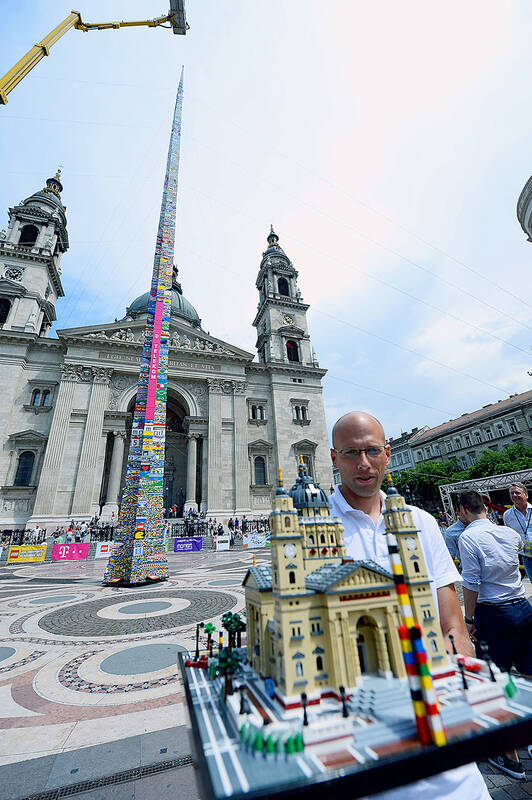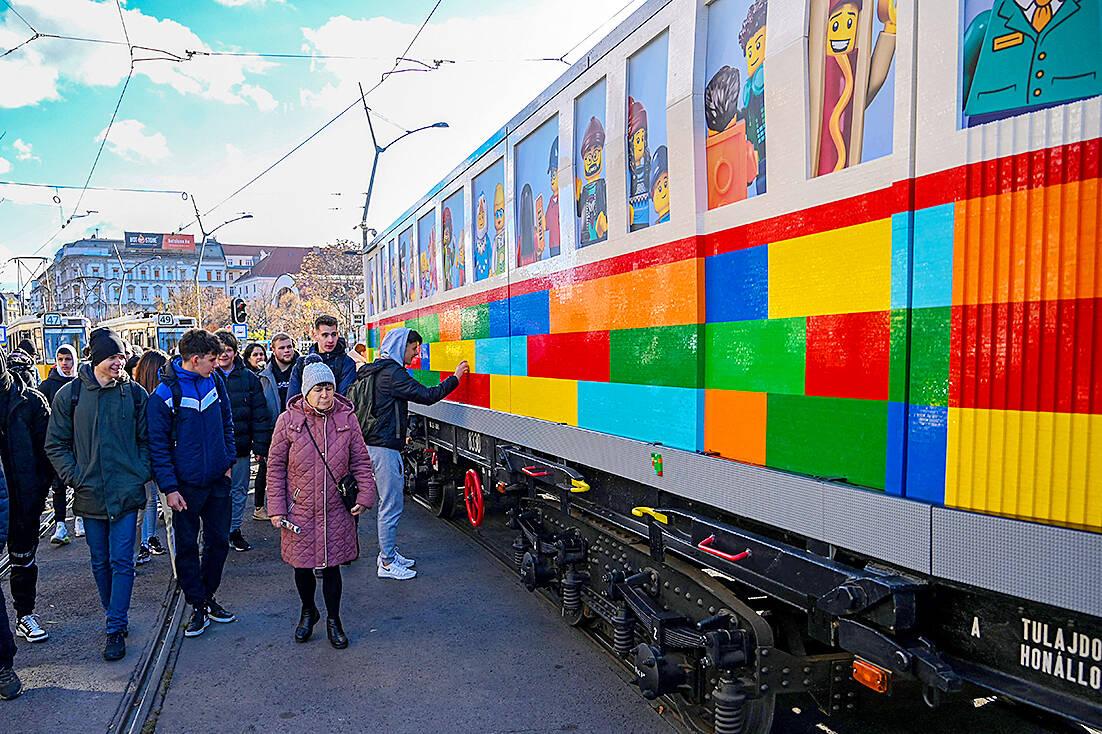To build his giant Lego structures which usually take hundreds of thousands of bricks, Hungarian artist Balazs Doczy first must solve major “engineering challenges.”
“Every structure has an Achilles’ heel. Once it is solved, the rest of the work is easy,” the 48-year-old said.
He needed 90 helpers for one of his most recent works — a life-sized Lego tram made up of a staggering 1.8 million pieces.

Photo: AFP
Together they put in around 6,800 hours to assemble Doczy’s most ambitious project that is now on display in a bustling square in central Budapest.
The 11-meter-long Lego tram — commissioned by Budapest’s transport companies and its tourist office to “public transport and creativity” — has attracted droves.
“We’ve never seen anything like this before,” said Malaysian tourist Lucas Chang, 32, while dance coach Barbara Rajnai said children in her son’s and daughter’s kindergarten told them to check it out.

Photo: AFP
‘MEGASTRUCTURES’
A professional Lego artist for more than 10 years, Doczy works more like an architect than a builder, relying on specialist software to draw up plans and only assembling bricks when he needs to test out a particular design.
“Initially, I do preliminary sketches much like a painter, stacking bricks on each other in a digital environment,” he said.
“I set up the scale, identifying recognizable elements and proportioning the other parts relative to that.”
For his intricate dioramas, such as his model of the Heroes’ Square in Budapest, every piece has to imitate a specific detail.
In “megastructures” such as the tram, imperfections even as small as a tenth of a millimeter could stack up, leading to instability, he said.
“I always compare it to quantum mechanics and gravity: in a smaller scope matter behaves differently than on a grander scale,” he said.
Thus blocks are glued together, an internal frame is added for extra support and experts are consulted to ensure structural integrity.
Doczy also added some baseplates on its sides to allow people to place their own Lego bricks, which “has always appealed to me, because it allows anyone to express their creativity and transform the sculpture into a community piece.”
Doczy was fascinated with Lego at an early age, assembling bricks with his older brother, though Western products were in short supply in then-communist Hungary.
“We begged the neighbor’s kids to bring their sets too, so we could build bigger structures. We had ambitions even back then,” Doczy recalled.
His childhood passion was reignited years later when his nephew became captivated by the colorful blocks.
When he looked at his brother, “our eyes lit up and we realized we should start building again,” Doczy said.
Moving back to Hungary from Indonesia — where he had been teaching diving — he and his brother set up a business called “Brick Workshop” in 2013 to create Lego designs and organize activities for children and adults.
‘TOO VALUABLE TO THROW’
In 2014, Doczy’s Lego model of Budapest’s iconic St. Stephen Basilica was featured at a Guinness World Record attempt, when volunteers constructed the world’s highest Lego tower at the time in front of the basilica.
Three years later, he was officially recognized as a “Lego certified professional” (LCP) by the Danish company.
The coveted title — currently held by around two dozen creators — is awarded to talents who “create stunning, innovative designs that help push the boundaries of creativity and engineering,” a Lego spokesperson said.
The perks are being able to regularly consult with other LCPs and access Lego’s sculpting software that allows Doczy to order “from the 14,000 different pieces in production,” he said.
But for some projects, he has to scour the thriving second-hand market to search for pieces. Luckily for him, even bricks from the 1970s can be found there.
“As a diver, I’ve never seen Lego bricks pulled out of the sea,” said Doczy, who divides his time between Budapest and the Spanish island of Mallorca. “They are just too valuable to be thrown away.”

On April 26, The Lancet published a letter from two doctors at Taichung-based China Medical University Hospital (CMUH) warning that “Taiwan’s Health Care System is on the Brink of Collapse.” The authors said that “Years of policy inaction and mismanagement of resources have led to the National Health Insurance system operating under unsustainable conditions.” The pushback was immediate. Errors in the paper were quickly identified and publicized, to discredit the authors (the hospital apologized). CNA reported that CMUH said the letter described Taiwan in 2021 as having 62 nurses per 10,000 people, when the correct number was 78 nurses per 10,000

As we live longer, our risk of cognitive impairment is increasing. How can we delay the onset of symptoms? Do we have to give up every indulgence or can small changes make a difference? We asked neurologists for tips on how to keep our brains healthy for life. TAKE CARE OF YOUR HEALTH “All of the sensible things that apply to bodily health apply to brain health,” says Suzanne O’Sullivan, a consultant in neurology at the National Hospital for Neurology and Neurosurgery in London, and the author of The Age of Diagnosis. “When you’re 20, you can get away with absolute

May 5 to May 11 What started out as friction between Taiwanese students at Taichung First High School and a Japanese head cook escalated dramatically over the first two weeks of May 1927. It began on April 30 when the cook’s wife knew that lotus starch used in that night’s dinner had rat feces in it, but failed to inform staff until the meal was already prepared. The students believed that her silence was intentional, and filed a complaint. The school’s Japanese administrators sided with the cook’s family, dismissing the students as troublemakers and clamping down on their freedoms — with

As Donald Trump’s executive order in March led to the shuttering of Voice of America (VOA) — the global broadcaster whose roots date back to the fight against Nazi propaganda — he quickly attracted support from figures not used to aligning themselves with any US administration. Trump had ordered the US Agency for Global Media, the federal agency that funds VOA and other groups promoting independent journalism overseas, to be “eliminated to the maximum extent consistent with applicable law.” The decision suddenly halted programming in 49 languages to more than 425 million people. In Moscow, Margarita Simonyan, the hardline editor-in-chief of the